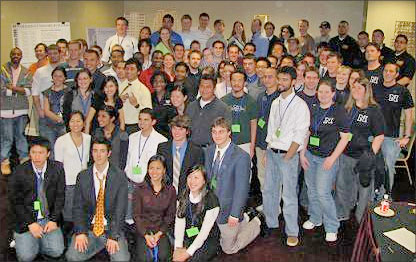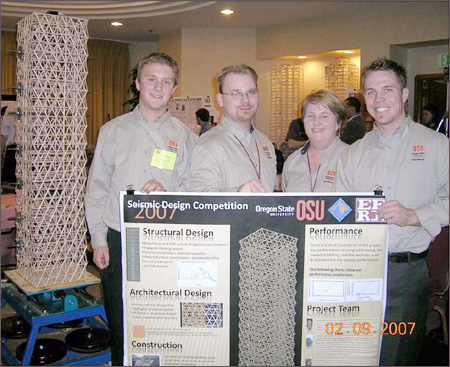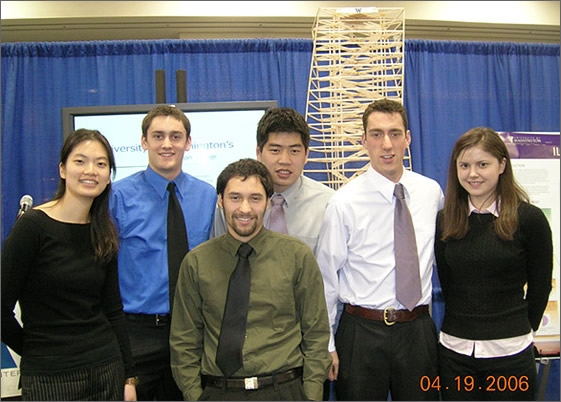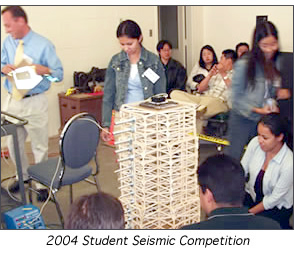Student Design Competition
PEER hosted the inaugural Seismic Design Competition in 2004. It was traditionally held at EERI Annual Meeting to gain exposure by practicing engineers and researchers. In 2008, the organization of this competition was transfered to EERI. See the EERI website for more info about recent competitions.
The 2008 Seismic Competition
The 5th Seismic Design Competition was held in New Orleans during the Earthquake Engineering Research Institute (EERI) Annual Meeting, February 6-9 2008. More.

Oregon State University Wins 2007 Seismic Design Competition
Of the 14 competing student teams, Oregon State University took first place in the 4th Annual Seismic Design Competition for Undergraduates, jointly sponsored by the Pacific Earthquake Engineering Research Center (PEER), Earthquake Engineering Research Institute (EERI), Mid-America Earthquake (MAE) Center and MCEER. The event, held during the EERI Annual Meeting, February 7-10, in Los Angeles, was an opportunity to demonstrate performance-based, cost-effective seismic design. Read more.

- 1st Place: Oregon State University
- Jeremy Mikkelsen, Joseph Henry, Sarah Martin, Beth McNair and Robert "Josh" Lehn
University of Washington Wins 2006 Seismic Design Competition
Of the eight competing student teams, the University of Washington took first place in the 3rd Annual Seismic Design Competition for Undergraduates, jointly sponsored by the Pacific Earthquake Engineering Research Center (PEER) and the Earthquake Engineering Research Institute (EERI). The event, held during the 100th Anniversary Earthquake Conference, April 18-21, at Moscone Center, was an opportunity to demonstrate performance-based, cost-effective seismic design.

University of Washington team members included Nathan Cross, Ryan Flynn, Yung-Ching Lu, Ina Karalic, Vincent Martinez, and Grace Wong.
Using balsa wood and glue, each participating team was required to design, analyze, fabricate, and subject a scaled model of a 30-floor office building to earthquake motions of up to 7.2 magnitude on a shake table. In addition, each team was required to discuss how its model could deliver the highest financial return for the building's owner over its lifetime.
The judges included Bruce Deam, University of Canterbury, Christchurch, New Zealand; David Gwie, Rutherford & Chekene, San Francisco, CA; Meaghan Koch, Geomatrix Consultants, San Francisco, CA; and Sarah Besser, Forrell Elsesser, San Francisco, CA.
Second and third place winners in the competition were the University of California at Berkeley and the University of Buffalo/State University of New York, respectively. Other participating teams included Oregon State University, University of California at Davis, University of California at San Diego, University of Hawaii, and Georgia Institute of Technology. The competition is open to all undergraduates, and all three of the National Science Foundation (NSF) earthquake engineering centers in the U.S. were represented: Pacific Earthquake Engineering Research Center (PEER), the Multidisciplinary Center for Earthquake Engineering Research (MCEER), and the Mid-America Earthquake Engineering Research Center (MAE).
The competition was made possible through support from PEER, EERI, and volunteer efforts of the Student Leadership Council (SLC). A $900 cash prize was awarded to the top three teams by Refraction Technology.
Next year's competition is tentatively scheduled for Los Angeles.
2004 Seismic Design Competition


